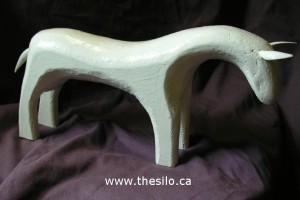
What is folk art? Any precise definition of art is by nature a slippery process and open to question.
“Folk art” is a term applied to diverse objects, like a highly organized Mennonite fracture drawing which expresses a collective, ethically based decorative tradition. Yet it is also applied to the more individualistic outpourings of any untrained painter, sculptor or other art practitioner.
Folk art is usually one step beyond the mundane. Not just a container to bring water to the mouth for survival (cupped hands for example), but instead a cup lovingly fashioned to bring pleasure or attract notice even when it is not being used, such as an intricately carved canoe cup.
On another level we can simply say that folk art is the art of ordinary people. It is sometimes called “primitive art” or “the people’s art” because by definition the artist has not been academically trained.
Folk art is made for one or more of three reasons: to share beliefs and traditions, to make some useful object beautiful, or to express one’s feelings.
Folk art, by definition has been produced and appreciated since cavemen and women started smearing blood and feces on cave walls, but the academic study of folk art is a relatively new thing. An English writer named William John Thomas first coined the phrase “folk lore” in 1848. At the time most anthropologists considered folklore to be worthless peasant creations. They were more interested in studying artifacts such as weapons and tools. It was through popularized folk tales by the likes of the Brothers Grimm that peasant traditions and art forms became interesting to the intellectual class.
I would argue that folk art did not show up on the radar of fine art institutions until around the turn of the century in Paris when Pablo (Picasso) and the boys flipped-out over the African art they saw for the first time, and started producing what today is called modern art. This led to a wider acceptance of all forms of art.
Folk art has become increasingly popular and more frequently studied in Canada, beginning in earnest after Expo ’67 gave us a greater appreciation of who we are as a nation. For the Silo, Phil Ross.
Featured image- Selections from Jim Linderman’s collection of folk art sewer pipe sculptures made by workers from leftover pipe clay. Photo: Oresti Tsonopoulos
